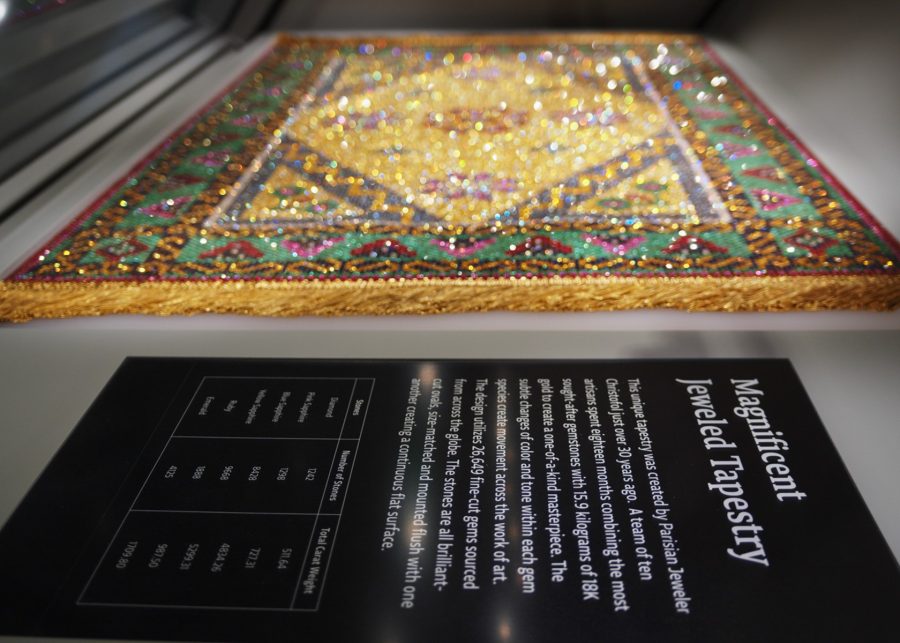With the cooler weather, the streets of Tucson are bustling with more people than usual. As people visit the open-air art markets and many culinary delights of Downtown Tucson, they may find themselves unsure of where to go next. To that end, I recommend anyone with the time and access to downtown visit the University of Arizona Alfie Norville Gem & Mineral Museum.
Housed in the historic Pima County Courthouse, the gem and mineral museum has a new location. Longtime residents of Tucson and rock enthusiasts may already be aware that despite the new home in the Historic Pima County Courthouse, the museum has been around the university since 1893.
The current museum’s existence has a romantic origin story. The namesake of the museum, Alfie Norville, was a passionate advocate for education regarding gems and minerals. Following her death, her husband Allan Norville helped to bring about the current version of the museum to immortalize and continue her work for all to see. Alfie Norville was instrumental in founding the Gem and Jewelry Exchange and keeping the yearly gem and mineral festival in Tucson.
In order to do justice to such a historic institution I knew so little about, I called Jordan Halter, the guest services coordinator for the museum, to ask her more about it. When I asked her on the phone about this “hidden gem,” she feigned offense at the use of the label, saying that “gems aren’t meant to be hidden; they’re meant to be on display.”
As a lover of both history and shiny rocks, I just had to see the display for myself. The first thing you should know about the museum is that it’s deceptively large. Admission is reasonable for the size of the collection in the museum, as students are able to get in for only $5. Admission is also come and go, which is perfect because in order to see everything, you’ll need ample time and calories. To address the latter, you’ll benefit from the fact that the tasty Five-To-Oh! Coffee shop is right next door to the museum entrance.
I had hoped to write descriptively about my experience exploring the extensive galleries and displays of the museum, but the experience was nothing short of overwhelming. There were thousands of gems to observe, many of which seemed more fit for the eyes of royalty than a mere mortal such as myself. Furthermore, the gems on display were surrounded by precious minerals and metalwork that would shame most modern jewelers. While I was personally blown away by all of the smoky quartz on display, Halter recommends you take some extra time to appreciate the Paraiba Tourmaline. The collection is incredibly impressive, and even more impressive is how knowledgeable the staff is about said collection.
When walking through the halls of the exhibits, I was greeted by numerous volunteers who seemed just as interested in the exhibits as myself. Many times I had the pleasure of walking into a room to a sight that would give pause to even those volunteers who see it far more often than myself.
Halter identified herself as the originator of the program that brought in over 25 docents to roam the floor sharing their experiences with interested guests. I enjoyed the opportunity to learn more about the shiny spectacles before me from people with inside experience, often either as jewelers or collectors in their time. In addition to the inside experience that they bring, Halter informed me that the docents all undergo a standardized orientation process so every volunteer will be able to provide an enriching experience for guests regardless of their background.
RELATED: A collection for the community: UA museum offers new opportunities for learning
One thing I found myself appreciating about the museum was the way in which an experience is curated with science front and center every step of the way. The museum itself is organized in a way that follows the chronology of the discovery of certain minerals. Furthermore, the displays take great care to show all aspects of the process, from the formation of the crystals to their removal from the ground via different mining methods.
Halter described the gallery curation as turning “science into art” in a way that allows the ancient tradition of being fascinated by crystals to continue. It is rare to walk through a museum that is able to use gallery design to organically educate visitors on the scientific processes underlying the gorgeous specimens on display. Many displays even encourage active participation providing visitors the opportunity to compare minerals by their touch and see their different applications.
The museum is open Tuesday through Saturday from 10 a.m. to 4 p.m. When I visited, I observed parents visiting with their children, couples on dates, friends hanging out and retirees leisurely exploring. As such, I don’t think it would be unreasonable to say that there is something for everyone. With the frequently rotating exhibits, as much as 30% per year according to Halter, be sure to go as soon as you can so you don’t miss out on their current displays!
Follow the Daily Wildcat on Twitter

Ben Pope is a second-year medical student at the UA. Although native to Tempe, he has moved down south to study medicine and enjoy all the good food Tucson has to offer.









